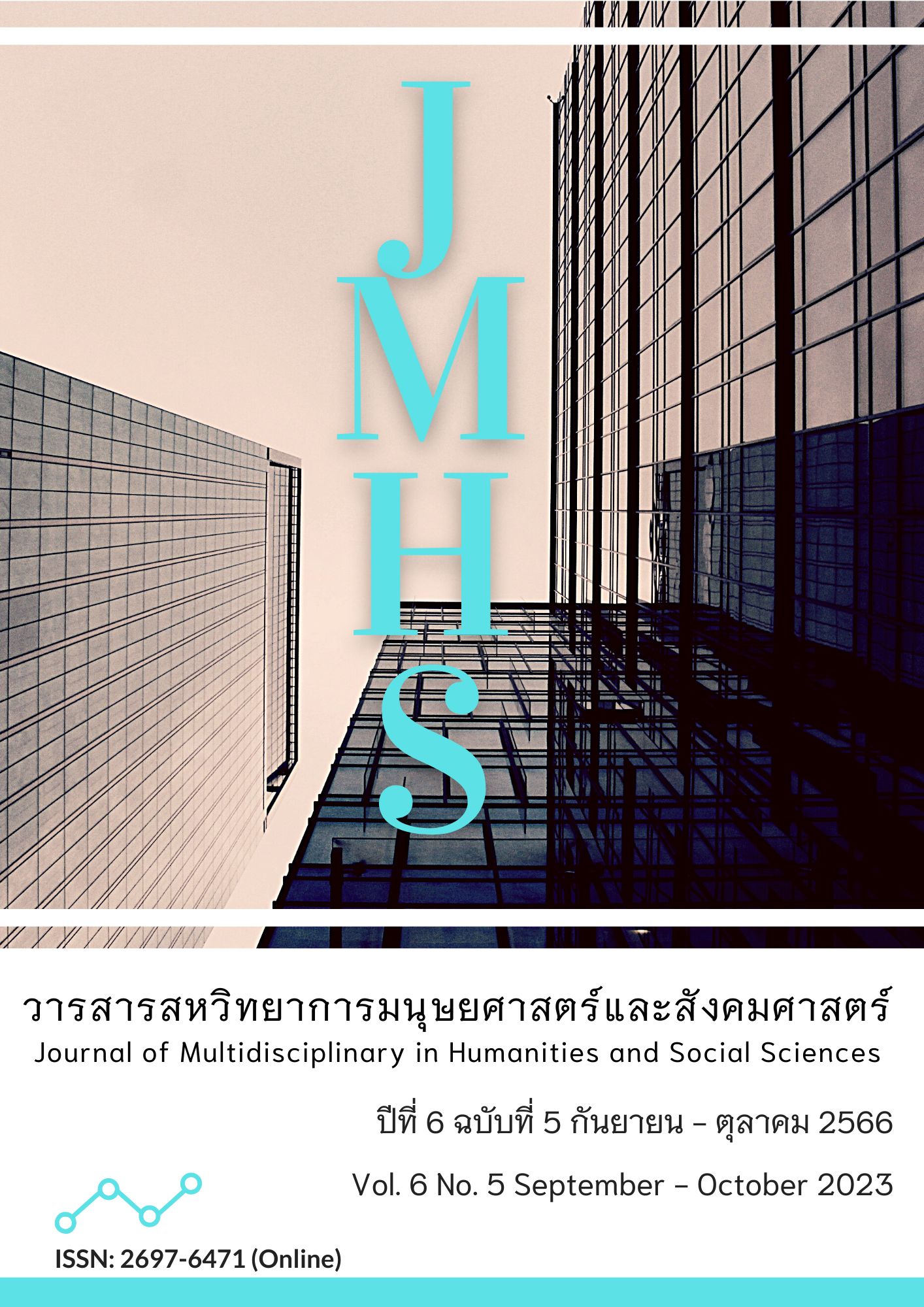Influence of Reference Groups and Attitudes towards Self-appearance on Consumers' Decision to Undergo Cosmetic Surgery in Bangkok
Main Article Content
Abstract
The purpose of this research was to investigate the influence of reference groups and attitudes toward one's appearance on the decision-making of consumers in Bangkok regarding cosmetic surgery and the intermediate influence on the desire for plastic surgery. This study was quantitative research. The study population consisted of general consumers living in Bangkok who were interested in cosmetic surgery. Convenient random sampling was performed for 400 samples using a questionnaire. The data were analyzed using descriptive statistics (frequency, percentage, mean, and standard deviation). Structural equation model analysis was used to test the hypothesis.
The research results showed that the revised structural equation model fits well with the empirical data. The influence of reference groups and self-appearance attitudes did not directly affect the decision-making process for cosmetic surgery. However, indirectly, it has a positive effect on the decision-making process for cosmetic surgery among consumers in Bangkok through the desire for cosmetic surgery, with a statistically significant level of .00 and a predictive power of 86%. The knowledge and findings from this research include: 1) sharing positive experiences is one form of developing effective communication strategies with customers (P); 2) life experiences of individuals who have made decisions regarding cosmetic surgery (L); 3) influencing arts to manipulate people's hearts by motivating other consumers to have positive perceptions of cosmetic surgery (A); and 4) persuading arts to influence consumers' minds by better understanding their desires regarding cosmetic surgery (M).
Article Details

This work is licensed under a Creative Commons Attribution-NonCommercial-NoDerivatives 4.0 International License.
Views and opinions appearing in the Journal it is the responsibility of the author of the article, and does not constitute the view and responsibility of the editorial team.
References
กนกวลี คงสง. (2558). การรับรู้เพศชายของวัยรุ่นในกรุงเทพมหานครต่อการผ่าตัดใบหน้า. Journal of WEI Business and Economics, 4(1), 54–62.
กัญชรส สุขลิ้ม, พระมหาหรรษา ธมฺมหาโส, ขันทอง วัฒนะประดิษฐ์ และ พระเมธาวินัยรส. (2563). การเสริมสร้างกระบวนการตัดสินใจการทำศัลยกรรมความงามของสตรีโดยหลักพุทธสันติวิธี. วารสารสันติศึกษาปริทรรศน์ มจร, 8(ฉบับเพิ่มเติม), 226–238.
จิราวุฒิ หลอมประโคน, ชษาพิมพ์ สัมมา และ วรงรอง ศรีศิริรุ่ง. (2562). ปัจจัยการตลาดและพฤติกรรมของนักท่องเที่ยวที่มาตลาดน้ำทุ่งบัวแดงจังหวัดนครปฐม. วารสารวิจัยรำไพพรรณี, 13(2), 73-82.
ชนิภรณ์ แก้วเนิน, ณัฐนรี สมิตร และ อรรถเวทย์ พฤกษ์สถาพร. (2563). พฤติกรรม การรับรู้ และทัศนคติของผู้บริโภคต่อสินค้าและการใช้บริการตามกระแสเกาหลีนิยม. วารสารวิทยาลัยดุสิตธานี, 14(3), 277–294.
ณัฐณิชา ทองใบ, ฐาศุกร์ จันประเสริฐ และ กัญญ์ฐิตา ศรีภา. (2560). ประสบการณ์การเสพติดศัลยกรรมความงาม ผู้เสพติดศัลยกรรมความงามใบหน้าปรากฏการณ์วิทยา. วารสารสุขศึกษา, 40(1), 53–68.
ทัศนีย์ น้อยเลิศ. (2556, 4 มกราคม). ปัญหาค่านิยมกับการทำศัลยกรรมของวัยรุ่นไทย. สืบค้นเมื่อ 2 พฤศจิกายน 2565, จาก http://sd-group1.blogspot.com/2013/01/53241943.html.
ธนัชชา ศรีชุมพล และ บุญญรัตน์ สัมพันธ์วัฒนชัย. (2561). ปัจจัยที่มีผลต่อการตัดสินใจทำศัลยกรรมเสริมความงามของผู้ใช้บริการชาวไทยที่อยู่ในเจเนอเรชัน X และเจเนอเรชัน Y ในเขตกรุงเทพมหานคร. วารสารมหาวิทยาลัยพายัพ, 28(2), 107–116.
นลินทิพย์ ภัคศรีกุลกำธร. (2562, 30 ธันวาคม). เสพติดความสวย! คนไทยแห่พึ่งศัลยกรรมติด TOP 8 ของโลก มูลค่าตลาดทะลุ 5.5 หมื่นล้าน. สืบค้นเมื่อ 2 พฤศจิกายน 2565, จาก https://positioningmag.com/1258926.
ปฐมาพร เนตินันทน์. (2556). การโฆษณากับพฤติกรรมผู้บริโภค. กรุงเทพฯ: มหาวิทยาลัยเกษตรศาสตร์.
ผู้จัดการออนไลน์. (2562, 26 ธันวาคม). คนไทยแห่พึ่งศัลยกรรมทำสวย ติด TOP 8 ของโลก มูลค่าตลาดทะลุ 5.5 หมื่นล้านบาท. สืบค้นเมื่อ 2 พฤศจิกายน, จาก https://mgronline.com/business/detail/9620000123207.
พิมพ์พลอย ธรรมโชโต และ พรพรรณ ประจักษ์เนตร. (2560). ปัจจัยการสื่อสารการตลาดแบบบูรณาการและอิทธิพลของกลุ่มอ้างอิงต่อพฤติกรรมการทำศัลยกรรมความงามของประชากรในเขตกรุงเทพมหานคร. วารสารการสื่อสารและการจัดการ นิด้า, 3(2), 1–18.
รสพร บุบผะศิริ และ บุรณี กาญจนถวัลย์. (2560). แนวโน้มการทำศัลยกรรมเสริมความงาม และปัจจัยที่เกี่ยวข้องของนักเรียนหญิงระดับชั้นมัธยมปลายในโรงเรียนเขตกรุงเทพมหานคร. จุฬาลงกรณ์เวชสาร, 61(5), 677–688.
สุวัจนี เพชรรัตน์, พรทิพย์ เสี้ยมหาญ, ณรงค์ศักดิ์ รอบคอบ และ สรัญญา โยะหมาด. (2565). ปัจจัยทางการตลาดที่มีอิทธิพลต่อเจตคติในการทำศัลยกรรมเสริมความงามบนใบหน้าของนักศึกษาในสถาบันอุดมศึกษา จังหวัดสงขลา. วารสารสังคมศาสตร์และมานุษยวิทยาเชิงพุทธ, 7(6), 371–386.
อมรลักษณ์ เทพบุตร และ เกศกัญญา สัพพะเลข. (2559). ความพึงพอใจของผู้ป่วยศัลยกรรมช่องปากต่อการประคบเย็นด้วยเจลเก็บรักษาอุณหภูมิ. วารสารพยาบาลกาชาดไทย, 9(2), 119–131.
Akdevelioglu, Y., & Gumus, H. (2010). Eating disorders and body image perception Among university students. Pakistan Journal of Nutrition, 9(12), 1187–1191.
Anderson, D. L. (2017) Organizational development: The process of leading organizational change. (4th ed.). London: Sage.
Brown, S. D. (2016). Career development and counseling: Putting theory and research to work. Wiley: Hoboken.
Esnaola, I., Rodriguez, A., & Goni, A. (2010). Body dissatisfaction and perceived sociocultural pressures: Gender and age differences. Salud Mental, 33(1), 21–29.
Fardouly, J., Diedrichs, P. C., Vartanian, L. R., & Halliwell, E. (2015). Social comparisons on social media: The impact of Facebook on young
women's body image concerns and mood. Body Image, 13, 38–45.
Garner, D. M. (1997, January 30). The body image survey. Retrieved November 2, 2022, from https://www.researchgate.net/publication/288898292_The_body_image_survey.
Hair, J. F., Black, W. C., Babin, B. J., & Anderson, R. E. (2010). Multivariate data analysis. (7th ed.). Upper Saddle River, NJ: Prentice Hall.
Hiatt, J.M. (2006). ADKAR: A model for Change in Business. Government and our Community, Prosci. Loveland, Colorado: Prosci Learning Center Publications.
Johnson, M. D. (2018). Reference Group Influence on Product and Brand Purchase Decisions. Journal of Consumer Research, 9(2), 183–194.
Kotler, P., & Armstrong, G. (2010). Principles of marketing. New Jersey: Prentice Hall.
Kotler, P., & Keller, K. L. (2016). Marketing management. (15th ed.). Edinburgh: Pearson Education.
Kuhn, T. (1960). Engineering precedent for the work of Sadi Carnot. Archives Internationales d’Histoire des Sciences, 13, 251-255.
Mayer, M., & Baek, T.H. (2017). The moderating effect of appearance self-esteem on females’ identification of and reaction to sexually-themed advertising. Journal of Business Diversity, 17(1), 10-20.
Meng, J., & Pan, P. (2012). Third-person perception of cosmeceutical product advertising: The moderating role of body esteem. Journal of Medical Marketing, 14(2-3), 163–171.
Newcomb, M. T. (1954). Social Psychology. New York: Dryden.
Perloff, R. M. (2014). Social media effects on young women’s body image concerns: Theoretical perspectives and an agenda for research. Sex Roles, 71(11-12), 363–377.
Schiffman, L. G., & Kanuk, L. L. (2010). Consumer behavior. (9th ed.). Englewood Cliffs, N.J.: Pearson Prentice Hall.
Smith, J. (2019). Understanding student consumer decision-making in healthcare: A qualitative study. Journal of Health Economics, 26(3), 45–58.
Smith, R. D. (2017). Strategic planning for public relations. (5th ed.). New York: Routledge.
Souad, M., Ramdane, T., Ghada, T., & Seemin, M. (2018). Cosmetic surgery and body image in adolescents: A psycho-sociological analysis of the causes and effects. International Journal of Humanities and Social Science, 8(10), 129–135.
Wood-Barcalow, N. L., Tylka, T. L., & Augustus-Horvath, C. L. (2010). “But I like my body”: Positive body image characteristics and a holistic model for young-adult women. Body Image, 7(2), 106–116.


